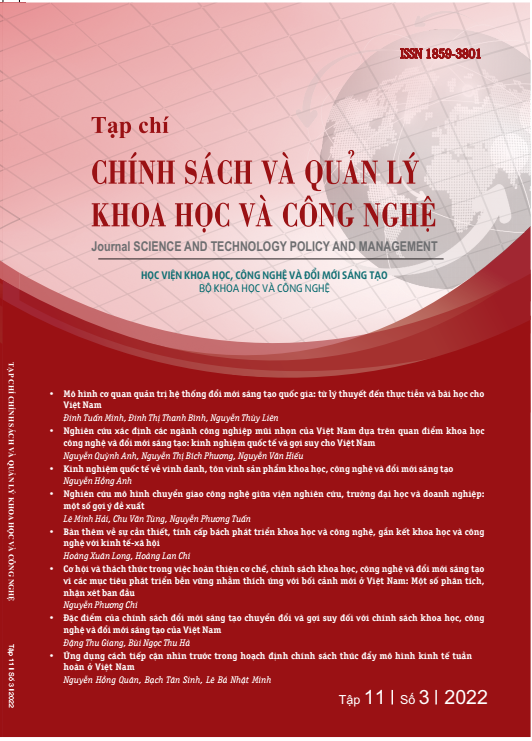Ứng dụng cách tiếp cận nhìn trước trong hoạch định chính sách thúc đẩy mô hình kinh tế tuần hoàn ở Việt Nam
Từ khóa:
Kinh tế, Kinh tế tuần hoàn, Tiếp cận nhìn trước, Chính sách STITóm tắt
Giải quyết các thách thức về tính bao trùm và bền vững trong bối cảnh Chương trình Nghị sự 2030 về Phát triển bền vững (Chương trình) yêu cầu: (a) mở rộng trọng tâm chiến lược của chính sách khoa học, công nghệ và đổi mới sáng tạo (STI) để lồng ghép các thách thức xã hội vào nội dung cốt lõi của Chương trình; (b) lồng ghép những đóng góp trực tiếp và gián tiếp của các đổi mới đối với các khía cạnh kinh tế, xã hội và môi trường của phát triển bền vững; và (c) thúc đẩy những đổi mới mang tính chuyển đổi với tiềm năng thay thế các hệ thống và thực tiễn không bền vững hiện hành (UNCTAD, 2019). Bài viết cung cấp kinh nghiệm quốc tế trong ứng dụng cách tiếp cận nhìn trước (foresighting) cho hoạch định chính sách STI theo định hướng thúc đẩy những đổi mới sáng tạo mang tính chuyển đổi với tiềm năng thay thế mô hình kinh tế tăng trưởng truyền thống sang mô hình kinh tế tuần hoàn. Trên cơ sở phân tích hiện trạng việc ứng dụng cách tiếp cận nhìn trước ở Việt Nam và kinh nghiệm quốc tế, bài viết đề xuất một số giải pháp nhằm tiếp tục thúc đẩy việc ứng dụng cách tiếp cận nhìn trước ở Việt Nam trong bối cảnh Việt Nam đang nỗ lực chuyển đổi mô hình kinh tế theo hướng tuần hoàn và thân thiện với môi trường.
Mã số: 22060601
Tải xuống
Tài liệu tham khảo
Cameron A và cộng sự (2019). Tương lai nền kinh tế số Việt Nam hướng tới năm 2030 và 2045. CSIRO, Brisbane, Úc.
Cameron A, T. Phan, J. Atheron (2018). “Việt Nam ngày nay”. Báo cáo đầu tiên của Dự án Tương lai Nền Kinh tế số, CSIRO, Brisbane. Úc
UNCTAD (2019). “The role of science, technology and innovation in building resilient communities, including through the contribution of citizen science”. Report of the Secretary- General. Geneva, 13-17 May 2019.
Apple (2017). “Environmental Responsibility Report. 2017 Progress Report, Covering Fiscal Year 2016”. <https://images.apple.com/environment/pdf/Apple_ Environmental_Responsibility_Report_2017.pdf>.
Bressanelli, Gianmarco, Federico Adrodegari, Marco Perona, and Nicola Saccani (2018). “Exploring How Usage-Focused Business Models Enable Circular Economy through Digital”. Sustainability 2018 10 (639). DOI:10.3390/ su10030639.
Cameron, A, Bach Tan Sinh and Sophiana Chua (2022). “The formation of a new community-of-practice to bring together public service foresight practitioners and inform science, technology and innovation activities across ASEAN Member States”. The Journal of Future Studies. (Forthcoming).
Cuhls, K (2017). “The Potential and limitation of Foresight. Conference Power from Statistics”. 19 October 2017. Fraunhofer Institute for Systems and Innovation Research. <https://ec.europa.eu/eurostat/cros/powerfromstatistics/DET/PfSPresentation Slides-Cuhls.pdf>.
Cuhls, K., (2003). “From forecasting to foresight processes? new participative foresight activities in Germany”. Journal of Forecasting, 22(2-3), pp.93-111.
Cuhls, K., (2003). “Government Foresight Activities in Germany: The Futur Process”. The second international conference on technology foresight.
Cuhls, K., Erdmann, L., Warnke, P., Toivanen, H., Toivanen, M., Van derGiessen, A., et al. (2015). Models of Horizon Scanning - How to integrateHorizon Scanning into European Research and Innovation Policies. Brussels: European Commission.
Ellen MacArthur Foundation (2016). “Intelligent Assets: Unlocking the Circular Economy Potential.” <https://ellenmacarthurfoundation.org/assets/downloads/ publications/EllenMacArthurFoundation_Intelligent_Assets_080216.pdf>.
European Commission (2020). “2020 Strategic Foresight Report - Charting the course towards a more resilient Europe”. <https://ec.europa.eu/info/strategy/priorities-2019-2024/new-push-european-democracy/
strategic-foresight/2020-strategic-foresight-report_en>
Gavigan, J. P., Scapolo, F., Keenan, M., Miles, I., Farhi, F., Lecoq, D., et al. (2001). “A practical guide to regional foresight” in European Commission ResearchDirectorate General, STRATA Programme, ed FOREN Network (Seville: Institutefor Prospective Technological Studies).
Jasanoff, S., and Kim, S.-H. (2015). Dreamscapes of Modernity: SociotechnicalImaginaries and the Fabrication of Power. Chicago: The University of ChicagoPress, London.
Liang, Lu-Hai, and Laura Paddison (2016). “Could 3D Printing Help Tackle Poverty and Plastic Waste?” The Guardian. Posted on November 6, 2016 <https://theguardian.com/sustainable-business/2016/nov/06/3d-printing-plastic-waste-poverty-development-protoprint-reflow-techfortrade>.
Lieder, Michael, Farazee M. A. Asif, and Amir Rashid (2017). “Towards Circular Economy Implementation: An Agent-Based Simulation Approach for Business Model Changes”. Autonomous Agents and Multi-Agent Systems 31 (6): 1377-402. DOI:10.1007/s10458-017-9365-9.
Loveridge, D. (2004). “Experts and foresight: review and experience”. Int. J. ForesightInnovation Policy 1, 33-69. DOI: 10.1504/IJFIP.2004.004651.
Miller, R. (2018). Transforming the future: anticipation in the 21st century. Paris; Abingdon, UK; New York, NY: UNESCO; Routledge.
Muirhead, Sam (2016). “How Open Source Can Accelerate The Circular Economy Shift.” Circulate News. Posted on April 13, 2016. <http://circulatenews.org /2016/04/how-open-source-can-accelerate-the-circular-economy-shift/>.
Schwab, Klaus (2016). “The Fourth Industrial Revolution: What It Means, How to Respond.” WEForum. Posted on January 14, 2016. <http://weforum.org/agenda/2016/01/the-fourth-industrial-revolution-what-it-means-and-how-to-respond/>.
Tonelli, M. and Cristoni, N., (2020). Strategic management and the circular economy. [s.l.]: Routledge.
Tegart, G. (2001). The current state of Foresight Studies. At Technology Foresight for Development Symposium, hosted by the Ministry of Science, Technology and Enviorment. APEC Centre for Technology Foresight and the National Institute for Science and Technology Policy and Strategy Studies April 23, 2001 in Hanoi.
Unruh, Gregory (2015). “The Killer App for 3D Printing? The Circular Economy.” MIT Sloan Management Review. Posted on December 8, 2015. .
Von Schomberg, R., Guimaraes Pereira, A., and Funtowicz, S. (2006). “Deliberating foresight knowledge for policy and foresight knowledgeassessment,” in Interfaces between Science and Society, eds S. Guedes Vaz, A. Guimarães Pereira, and S. Tognetti (Sheffield: Greenleaf Publishing).
Tải xuống
Đã Xuất bản
Cách trích dẫn
Số
Chuyên mục
Giấy phép
Các bài viết (bao gồm cả phần Tóm tắt) ....

